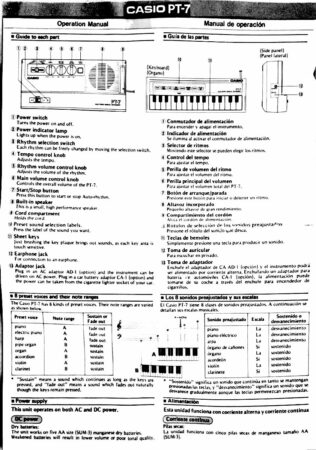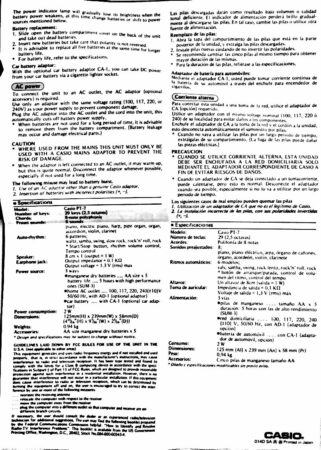Scan Gallery
Original manual photos courtesy of methinksit on eBay, from this auction. Converted to black and white, and OCR'd in Prizmo.
Transcription
CASIO PT-7
Operation Manual
Guide to each part
(Keyboard)
(Side Panel)
- Power switch
Turns the power on and off. - Power indicator lamp
Lights up when the power is on. - Rhythm selection switch
Each rhythm can be freely changed by moving the selection switch. - Tempo control knob
Adjusts the tempo. - Rhythm volume control knob
Adjusts the volume of the rhythm. - Main volume control knob
Controls the overall volume of the PT-7. - Start/Stop button
Press this button to start or stop Auto-rhythm. - Built-in speaker
This is a small, high performance speaker. - Cord compartment
Holds the cord. - Preset sound selection labels.
Press the label of the sound you want. - Sheet keys
Just brushing the key plaque brings out sounds, as each key area is touch sensitive. - Earphone jack
For Connection to an earphone. - Adaptor jack
Plug in an AC adaptor AD-1 (option) and the instrument can be driven on AC power. Plug in a car battery adaptor CA-1 (option) and the power can be taken from the cigarette lighter socket of your car.
8 preset voices and their note ranges
The Casio PT-7 has 8 kinds of preset voices. Their note ranges are varied as shown below.
| Preset voice | Note range | Sustain or Fade out |
|---|---|---|
| piano | A | fade out |
| electric piano | A | fade out |
| harp | A | fade out |
| pipe organ | B | sustain |
| organ | A | sustain |
| accordion | B | sustain |
| violin | A | sustain |
| clarinet | A | sustain |
- “Sustain” means a sound which continues as long as the keys are pressed, and “fade out” means a sound which fades out naturally though the keys remain pressed.
Power Supply
This unit operates on both AC and DC power.
DC Power
Dry batteries:
The unit works on five AA size (SUM-3) manganese dry batteries. Weakened batteries will result in lower volume or poor tonal quality.
The power indicator lamp will gradually lost its brightness when the battery power weakens, at this time change batteries or shift to power sources mentioned below.
Battery replacement:
- Slide open the battery compartment cover on the back of the unit and take out dead batteries.
- Insert new batteries but take care that polarity is not reversed.
- It is advisable to replace all five Batteries at the same time for longer battery life.
- For battery life, refer to the specifications.
Car battery adaptor:
With the optional car battery adaptor CA-1, you can take DC power from your car battery via a cigarette lighter socket.
AC power
To connect the unit to an AC outlet, the AC adaptor (optional accessory) is required.
Use only an adaptor with the same voltage rating (100, 117, 220, or 240V) as your power supply to prevent component damage.
Plug the AC adaptor into. the AC outlet and the cord into the unit, this automatically cuts off battery power supply.
- When batteries are not used for a long period of time, it is advisable to remove them from the battery compartment. (Battery leakage may occur and damage electrical parts.)
CAUTION
- WHERE USED FROM THE MAINS THIS UNIT MUST ONLY BE USED WITH A CASIO MAINS ADAPTOR TO PREVENT THE RISK OF DAMAGE.
- When the adaptor is left connected to an AC outlet, it may warm up, but this is quite normal, Disconnect the adaptor whenever possible, especially if not used for a long time.
The following misuse may lead to battery burst.
- Use of an AC adaptor other than a genuine Casio adaptor.
- Insertion of batteries with incorrect polarities (+, -).
Specifications
| Model: | Casio PT -7 |
| Number of keys: | 29 keys (2.5 octaves) |
| Chords: | 8-note polyphonic |
| Preset sounds: | 8 sounds piano, electric piano, harp, pipe organ, organ, accordion, violin, clarinet |
| Auto-rhythm: | 6 patterns; waltz, samba, swing, slow rock, rock ’n’ roll, rock • Start/Stop button, rhythm volume control, Tempo control |
| Speaker: | 8 cm x 1 (output = 1 W) |
| Earphone jack: | Output impedance = 0.1 KΩ Output voltage = 1.3 V (rms) max |
| Power source: | 3 ways • manganese dry batteries ….. AA size x 5 battery life ..... 5 hours with high performance ones (SUM-3) • home AC outlet ..... 100, 117, 220, 240(±10)V 50/60 Hz, with AD-1 (optional adaptor) • car battery ….. with CA-1 (optional car adaptor) |
| Power consumption: | 2 W |
| Dimensions: | 125mm(H) x 239mm(W) x 58mm(D) (4 15/26”(H) x 9 7/16”(W) x 2 5/16(D)) |
| Weights: | 0.94 kg |
| Accessories: | AA size manganese dry batteries x 5 |
* Design and specifications may be subject to change without notice.
GUIDELINES LAID DOWN BY FCC RULES FOR USE OF THE UNIT IN THE USA (not applicable to other areas).
This equipment generates and uses radio frequency energy and if not installed and used property, that is, in strict accordance with the manufacturer's instructions, may cause interference to radio and television reception. It has been type tested and found to comply with the limits for a Class B computing device in accordance with the specifications in Subpart 1 of Part 15 of FCC Rules, which are designed to provide reasonable protection against such interference in a residential installation. However, there is no guarantee that interference will not occur in a particular installation. If this equipment does cause interference to radio or television reception, which can be determined by turning the equipment off and on, the user is encouraged try to correct the interference by one or more of the following measures:
. . . reorient the receiving antenna
. . . relocate the computer with respect to the receiver
. . . move the computer away from the receiver
. . . plug the computer into a different outlet so that computer and receiver are on different branch circuits.
If necessary, the user should consult the dealer or an experienced radio/television technician for additional suggestions. The user may find the following booklet prepared by the Federal Communications Commission helpful: “How to Identify and Resolve Radio-TV Interference Problems”. This booklet is available from the US Government Printing Office, Washington D.C., 20402, Stock No.004-000-00345-4.
CASIO®
014D SA ® Printed in Japan

